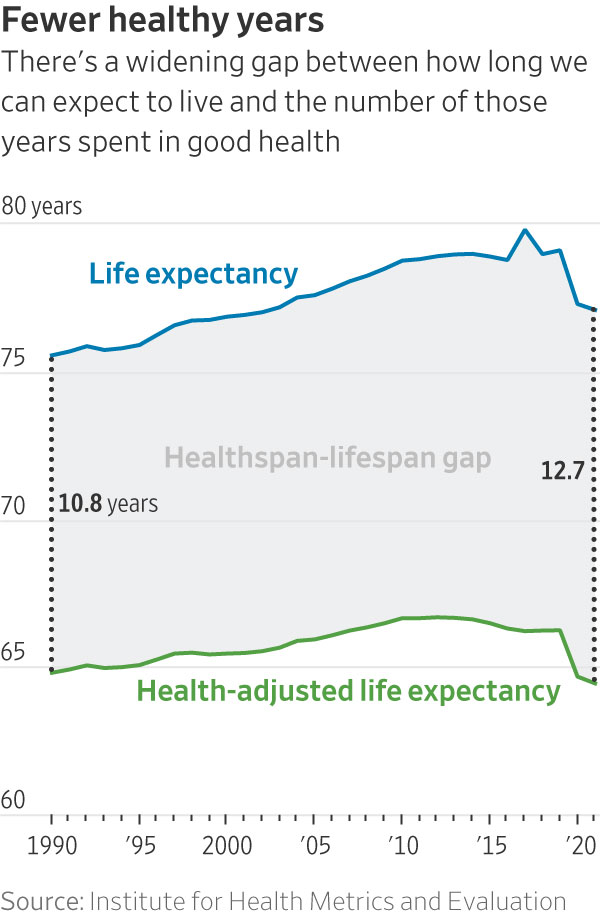Americans are living longer, but spending less time in good health.
The estimated average proportion of life spent in good health declined to 83.6% in 2021, down from85.8% in 1990, according to an analysis of the latest data from the Institute for Health Metrics and Evaluation’s Global Burden of Disease study, a research effort based at the University of Washington.
The decrease of time spent in good health is partly because medical advances are catching and treating diseases that once would have killed us. But it is also because of the rising prevalence, often among younger people, of conditions such as obesity, diabetes and substance-use disorders.
Declining health takes a deep physical and emotional toll on patients and their caregivers. There are also broad ramifications on society, including rising health costs that eat into household budgets, as well as more people who want to work but can’t.
“The period of life spent not healthy is getting larger and larger and the implications of that are enormous,” says Dr. John Rowe, a professor of health policy and aging at Columbia University. “70 is the new 80.”

In the Institute for Health Metrics and Evaluation data, life expectancy from birth increased from 75.6 years in 1990 to 77.1 years in 2021. Healthy life expectancy, a measure of how many years we can expect to enjoy good health, fell from 64.8 to 64.4 in the same period.
And the average estimated gap between our overall years and our good-health years grew from 10.8 to 12.7 years.
Healthspan
Doctors and researchers have a term for the number of years we live in good health: healthspan. Their definitions vary, but an easy way to think about it is the number of years we feel good.
Often, that includes years we spend free from disability or disease and can do the things we love. Some doctors use it as a measure of more specific health metrics related to our heart, lungs and brain.
The U.S. lifespan-healthspan gap is growing in large part because we are living longer, say demographers and aging researchers. U.S. life expectancy jumped from roughly 49 years to nearly 77 from the start of the 20th century to the end, according to Centers for Disease Control and Prevention data. It fell in recent years partly because of the pandemic but has recovered somewhat, per the CDC.
The more years of old age we get, the more opportunity we have to develop one or more age-related conditions—a consequence of success, not failure, says S. Jay Olshansky, an aging researcher and professor of public health at the University of Illinois at Chicago.
Health officials might also be catching more cases of diseases that they previously missed thanks to increased surveillance and diagnostic sensitivity, says Dan Belsky, an epidemiologist at Columbia University’s Robert N. Butler Aging Center. And treatment advances for many diseases have made living with chronic illness more manageable than in the past.
“We are living longer and better, even if the length of life with diseases increased,” says Eileen Crimmins, professor of gerontology at the University of Southern California who studies the social, biological and behavioral factors that influence life expectancy. “It’s better on average.”
But some conditions, such as substance-use disorders, obesity and diabetes, are also becoming more prevalent at earlier ages in the U.S. Growing rates of mental-health disorders, particularly among younger Americans, might also be hurting healthspan, public-health experts say.
In 2018, roughly 27% of U.S. adults had multiple chronic conditions, up from about 25% in 2012 and 22% in 2001, according to a Centers for Disease Control and Prevention study.
Taking a toll
Developing health conditions takes more than a physical toll. Having a substantial health problem reduces life satisfaction more than losing a job or becoming widowed, divorced or separated, according to a 2022 study published in the Journal of Economic Behavior and Organization.
Kathie McClure, an 81-year-old who lives in a senior living community in Goleta, Calif., says being active and a part of her community is much more important to her than living for a long time. Still largely in good health, she hikes, gardens, volunteers as a docent at her local botanical garden and goes on walks with her son’s dog, a mutt called Patrick.
McClure says she has no desire to live beyond the ability to perform and enjoy the daily activities she loves.
“If I can’t play pickleball, I don’t want to be here,” says McClure.
For many patients with heart disease, their first question about treatment isn’t whether it will help them live longer, but whether it will help them continue to ride a bike, play the trumpet or do other things they enjoy, says Dr. Andre Terzic, a regenerative-medicine and cardiovascular researcher at the Mayo Clinic.
“We don’t want to live to 100 if the last 20 years of that is in a nursing home or dealing with dementia or some other chronic disease,” says Dr. Zaldy Tan, who directs the Memory and Aging Program at Cedars-Sinai Health System in Los Angeles.
Other high-income countries have had increases in both lifespan and healthspan over the past three decades. The percentage of years that people in other high-income countries spend in good health has shrunk slightly, as it has in the U.S., but not to the same degree.
The U.S. does a worse job of ensuring access to preventive healthcare and screenings than many other wealthy nations, health researchers say. The U.S. invests heavily in end-of-life interventions that drive down deaths from diseases, but isn’t as focused on prevention of the disease itself, says Columbia’s Belsky.
Write to Alex Janin at alex.janin@wsj.com






